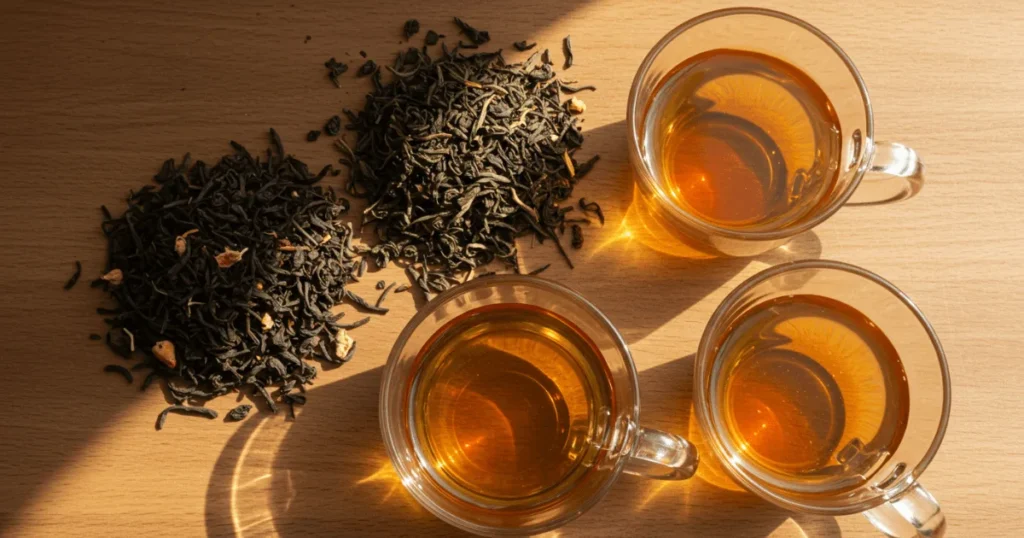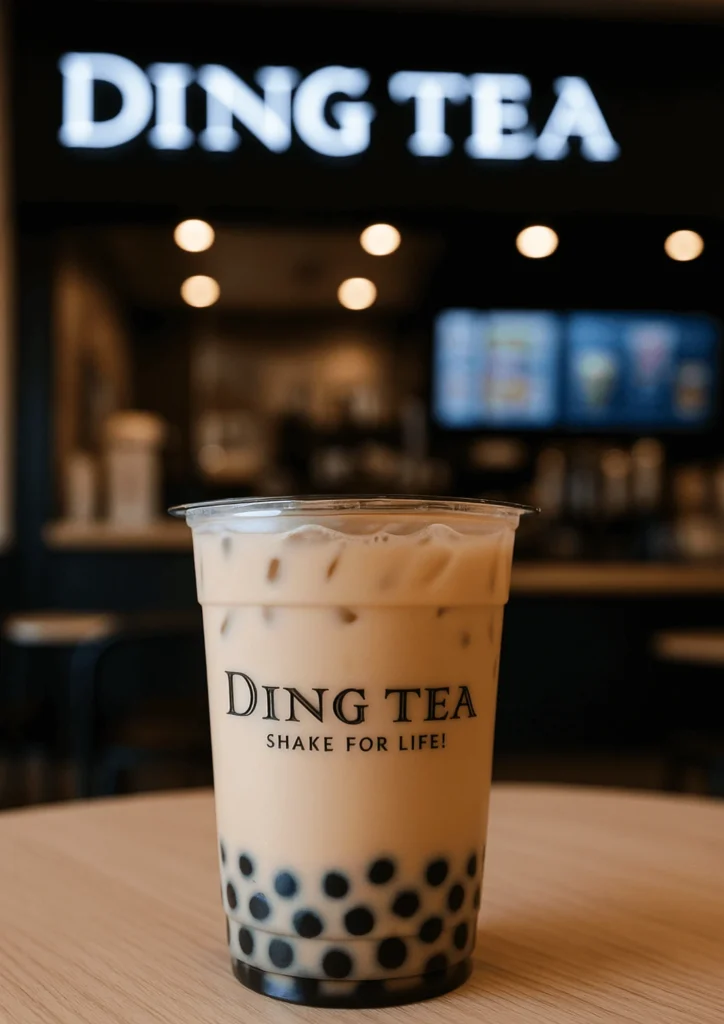When you walk into Ding Tea, you are immediately greeted by that sweet, dreamy smell of tea, sugar, and boba magic. Ice is shaking, drinks are swirling, and the menu is packed with names that make you want to try everything. But if you have ever paused mid-order and thought, “Wait… is this good for me?”—you are not alone. Let us break it all down, without the boring lecture vibes.
Table of Contents
The Ding Tea Story: From Taiwan to Your Neighborhood
Ding Tea is not just your average bubble tea shop—it has a real story behind it. Back in 2004, a man named Mr. In Taiwan, where bubble tea was born, Xu Wei-Xiang began this venture.. He noticed the growing love for bubble tea early on and decided to blend traditional tea-making with the customizable, fun atmosphere that people appreciate.
Today, Ding Tea has expanded, with over 650 shops around the world, including more than 100 here in the U.S. Spots like Ding Tea Balboa and Ding Tea Hawthorne have become local favorites, where people drop by for their go-to drinks. No matter where you go, the taste and quality are just as exceptional as that first sip in Taiwan.
What’s in a Ding Tea Drink?
Let us be real: the menu sounds amazing. Mango Green Tea? Brown Sugar Milk Tea? Count us in. But behind those mouth-watering flavors are some ingredients that might surprise you, both good and not-so-great.
The Tea Itself? Legitimate.
First, credit where credit is due—the tea base is authentic. Ding Tea does not use low-quality powdered bases. Their classic milk tea gets its bold flavor from Assam black tea, while green teas use jasmine leaves. Even the oolong tea has real depth—perfect for those who want a tea that tastes grown-up.
So, if you appreciate the health benefits of tea (hello, antioxidants!), Ding Tea delivers on that front.
The “Milk” in Milk Tea? Not What You Think.
Turns out Ding Tea’s “milk” is not real milk. They use a non-dairy powder called Bossen creamer instead, making the drink super smooth while allowing it to last outside the fridge (very handy).
If you are avoiding dairy—maybe due to lactose sensitivity or a desire for plant-based options—this might seem like a win. However, you miss out on the protein and calcium found in regular milk. Also, some of these creamers still have hidden milk ingredients. So, if you are strictly dairy-free, always ask before ordering.
The Sugar Situation (Brace Yourself)
Let us talk sugar—the main reason your bubble tea tastes so irresistible. Ding Tea lets you customize the sweetness, but if you go full-sugar for a large drink, you are looking at 40 to 60 grams of sugar. That is your entire daily limit in just one cup.
They use both fructose syrup and granulated sugar, depending on the specific drink. So while you are enjoying that sweet mango flavor, remember your liver is working overtime.
The fruity flavors mostly come from flavored syrups (Possmei, to be exact). So, there is not much “real” fruit—except in the avocado smoothies, which use real avocado. Kudos to them!
Toppings = Sugar Bombs in Disguise
Those chewy tapioca pearls? They are cooked and steeped in brown sugar syrup all day. So every slurp gives you an extra hit of sugar and carbs.
Want something lighter? Try aloe vera, or skip toppings altogether and focus on the tea itself. (Sometimes less is more.)

The Health Reality Check
I am not going to tell you that bubble tea is a health drink. It is not exactly liquid poison, either. Let us examine the facts.
The Good Stuff
Tea is not just a trendy drink for Instagram. It genuinely benefits your body. Antioxidants abound in green tea, acting as health superheroes, and black tea also has its advantages. Even when your drink is filled with boba, non-dairy milk, and extras, you are still getting some health advantages.
Let us also talk about hydration. To a few, having plain water appears to be an obligation. But with a flavorful tea? Suddenly, staying hydrated is easier. At times, your palate needs a bit of inspiration to support you in reaching your hydration objectives.
The Not-So-Great Stuff
The sugar content is high. Even when you reduce the sweetness, you are still likely consuming a significant amount of sugar. Fructose—a key sweetener—gets processed differently by your body compared to other sugars, and it does not help you feel full.
How to Hack Your Order for Better Health
Here is the beauty of Ding Tea: you can customize your drink for better health without sacrificing flavor.
Master the Sweetness Game
This is the top strategy for making your drink more health-conscious. If you always order 100% sweetness, you might think that is the “original” flavor. But when you start experimenting with 50% or even 25% sweetness, you will notice the real taste of the tea.
The Ice Strategy
Want to limit sugar? Stick to regular ice. Ordering “no ice” might seem like a better value, but they just add more tea concentrate and sugar to fill the cup. Regular ice keeps your sugar intake in check.
Topping Choices That Will Not Wreck Your Day
Crave texture? Select aloe vera as a substitute for tapioca pearls to enjoy a similar jelly sensation while consuming fewer calories. Or try your drink without any toppings—you might discover you love the tea’s flavor all on its own.
Base Selection Strategy
Want to reduce guilt? Choose fruit tea bases over milk tea. A lychee fruit tea at 25% sweetness is still bursting with flavor, but you skip the creamer and cut down on sugar.


What About the Ingredients?
Ding Tea is consistent with its ingredients. Their teas and syrups come from trusted brands like Teazone and Possmei, and they maintain strict prep standards for quality across locations. So your milk tea in Los Angeles should taste the same as your friend’s in Dallas.
Many syrups do include artificial colors and flavors, so it is not exactly “all-natural.” However, the brand is transparent about this and has passed international food safety standards (SGS Taiwan and 231 tests in Japan).
How Does Ding Tea Stack Up Against Other Brands?
Compared to big names like Gong Cha or Chatime, Ding Tea focuses more on authentic tea. They use real tea leaves and standardized recipes rather than pre-mixed powders—a big plus for tea lovers.
Still, Ding Tea is a bubble tea brand. Sugar, syrups, and the classic creamy-sweet combination are part of their identity.
Can Bubble Tea Be Part of a Healthy Lifestyle?
Yes—if you are smart about it. Enjoy Ding Tea as an occasional treat, and take advantage of their customization options to fit your diet.
Craving something after a workout? A fruit tea with real green tea and little sugar can be a refreshing boost. Just remember, bubble tea should not replace water for main hydration, and maybe do not pair it with a donut.
Quick Tips for Regulars
- Rotate between indulgent drinks and lighter, healthier options.
- Gradually decrease sugar—your taste buds will adapt.
- Occasionally, skip the toppings to let the tea’s flavor stand out.
- Try pairing a Ding Tea treat with a walk or workout to offset the sugar.
Bottom Line
No one is pretending Ding Tea is a salad. It is not a guilty pleasure you need to hide, either. The drinks are enjoyable—real tea, real ingredients—and with their customization options, you can find something that fits your taste and lifestyle.
Keep it real: That pastel-colored drink? It is a treat, not a detox potion. And everyone deserves a treat sometimes.
Whether you drop by Hawthorne for a caffeine fix or make an outing of your Balboa visit, own your choices. Pick what makes you happy, sip slowly, and savor the boba experience. No regrets.

Ding Tea FAQs
Is Ding Tea made with real tea?
Yes! They use genuine black, green, and oolong tea leaves—not powdered substitutes.
Is it healthy?
Kind of. The tea itself is beneficial, but the sugar content can be high. Balance is key.
What makes Ding Tea different from other bubble tea spots?
Real tea leaves, consistent quality, and international-level prep standards.
Can I make my drink healthier?
Yes! Lower the sugar, skip the toppings, and opt for fruit tea bases.
Do they use real fruit?
Mostly syrups. The avocado smoothie is the one drink made with real fruit.
Is it dairy-free?
Somewhat. The “milk” is a non-dairy creamer but may still contain milk-derived ingredients.
How much sugar is in a regular drink?
A large drink contains 40 to 60 grams of sugar, about your total daily allowance. So, go easy.

